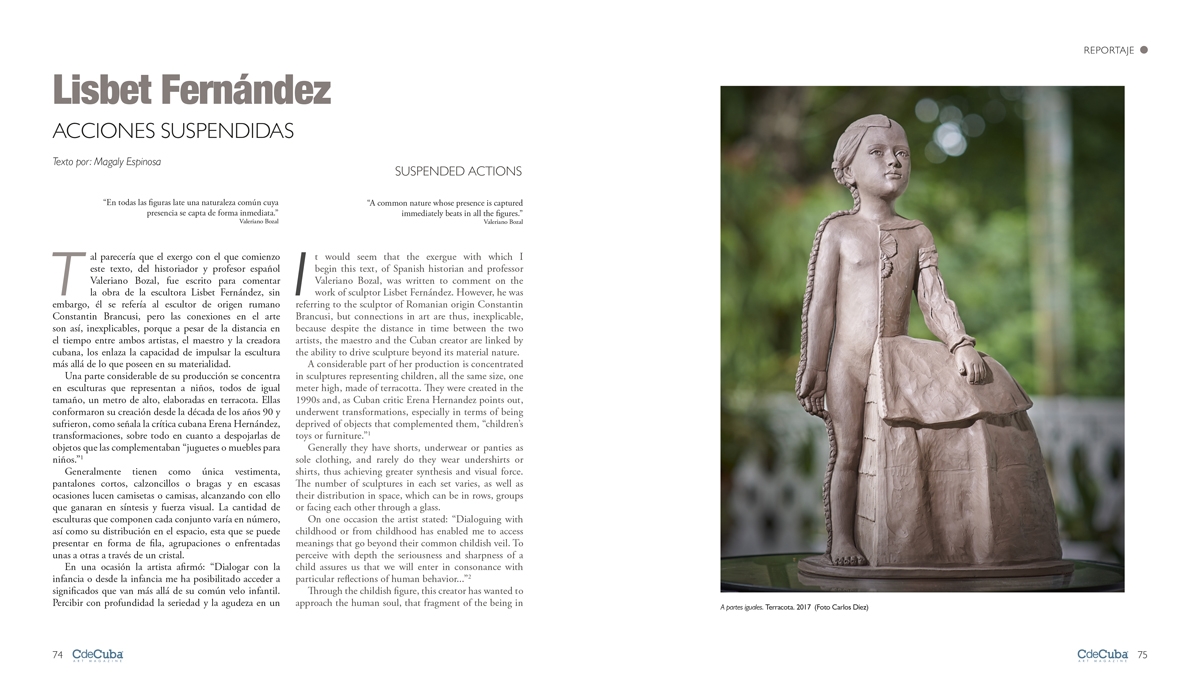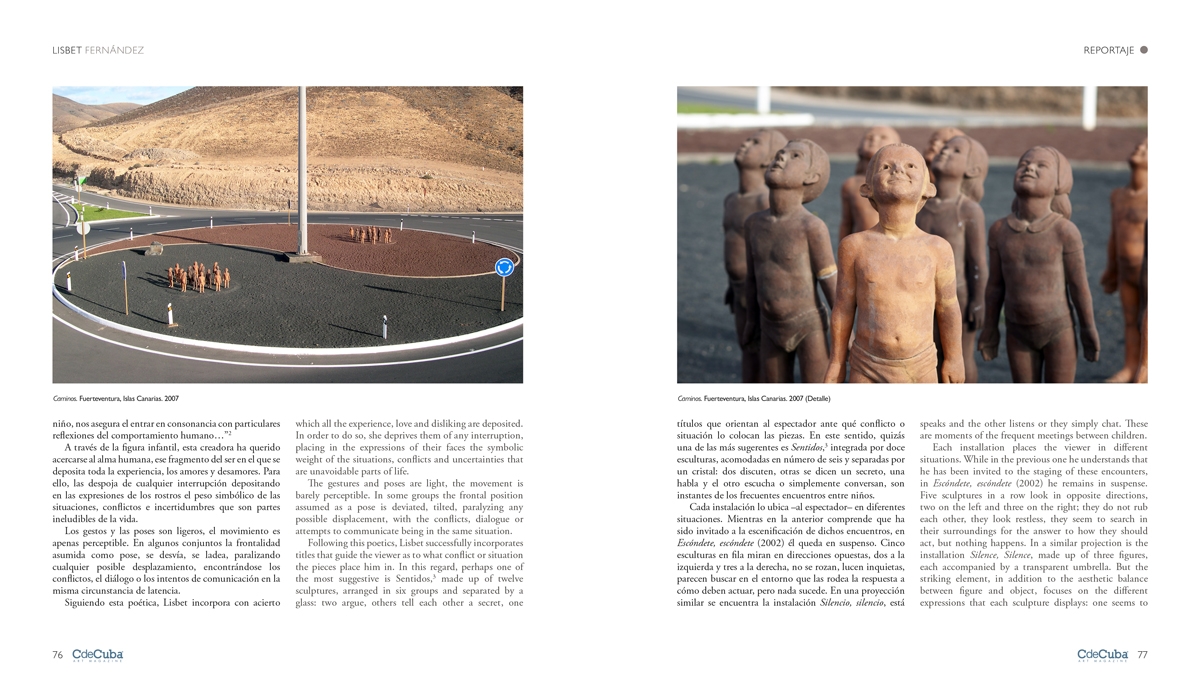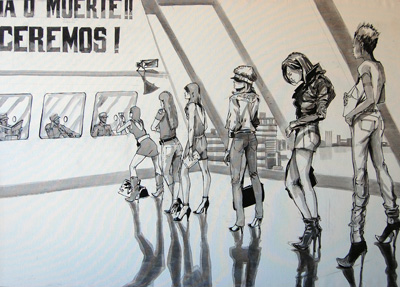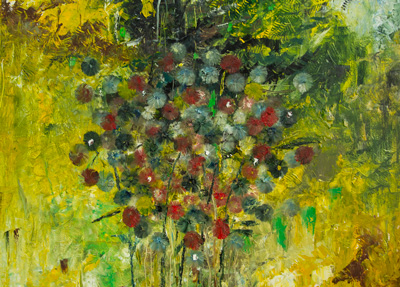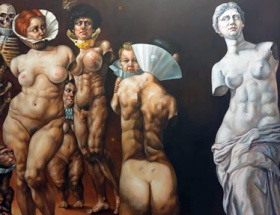[vc_row][vc_column][vc_column_text]
Suspended Actions
By Magaly Espinosa
“A common nature whose presence is captured immediately beats in all the figures.”
Valeriano Bozal
It would seem that the exergue with which I begin this text, of Spanish historian and professor Valeriano Bozal, was written to comment on the work of sculptor Lisbet Fernández. However, he was referring to the sculptor of Romanian origin Constantin Brancusi, but connections in art are thus, inexplicable, because despite the distance in time between the two artists, the maestro and the Cuban creator are linked by the ability to drive sculpture beyond its material nature.
A considerable part of her production is concentrated in sculptures representing children, all the same size, one meter high, made of terracotta. They were created in the 1990s and, as Cuban critic Erena Hernandez points out, underwent transformations, especially in terms of being deprived of objects that complemented them, «children’s toys or furniture.”(1)
Generally they have shorts, underwear or panties as sole clothing, and rarely do they wear undershirts or shirts, thus achieving greater synthesis and visual force. The number of sculptures in each set varies, as well as their distribution in space, which can be in rows, groups or facing each other through a glass.
On one occasion the artist stated: «Dialoguing with childhood or from childhood has enabled me to access meanings that go beyond their common childish veil. To perceive with depth the seriousness and sharpness of a child assures us that we will enter in consonance with particular reflections of human behavior…»(2)
Through the childish figure, this creator has wanted to approach the human soul, that fragment of the being in which all the experience, love and disliking are deposited. In order to do so, she deprives them of any interruption, placing in the expressions of their faces the symbolic weight of the situations, conflicts and uncertainties that are unavoidable parts of life.
The gestures and poses are light, the movement is barely perceptible. In some groups the frontal position assumed as a pose is deviated, tilted, paralyzing any possible displacement, with the conflicts, dialogue or attempts to communicate being in the same situation.
Following this poetics, Lisbet successfully incorporates titles that guide the viewer as to what conflict or situation the pieces place him in. In this regard, perhaps one of the most suggestive is Sentidos,(3) made up of twelve sculptures, arranged in six groups and separated by a glass: two argue, others tell each other a secret, one speaks and the other listens or they simply chat. These are moments of the frequent meetings between children.
Each installation places the viewer in different situations. While in the previous one he understands that he has been invited to the staging of these encounters, in Escóndete, escóndete (2002) he remains in suspense. Five sculptures in a row look in opposite directions, two on the left and three on the right; they do not rub each other, they look restless, they seem to search in their surroundings for the answer to how they should act, but nothing happens. In a similar projection is the installation Silence, Silence, made up of three figures, each accompanied by a transparent umbrella. But the striking element, in addition to the aesthetic balance between figure and object, focuses on the different expressions that each sculpture displays: one seems to ask, the other is astonished or in doubt and the third one has an expression of mistrust. It is unlikely that we find ourselves before a stage loaded with content that is capable of provoking such opposing emotions. But this is part of the artist’s ingenuity to dislodge the spectator from his habitual comfort. We will have to stop before her, meditate on what she intends to tell us and choose the possible circumstance that impresses us.
Another work loaded with meaning is Caminos (2007), located in a roundabout on the island of Fuerteventura. It presents two sets of figures, distributed on opposite sides, all looking up, some smiling, others a bit more serious, enjoying what is happening in the sky, without a possibility for us to participate in it.
Lisbet stops the narration, but nevertheless manages to make us meditate so we can inquire about the potential events. This aesthetic mechanism of communication is one of the praiseworthy values of her creation, since the content of the works emerges from the expressions of the faces, the way in which the figures are placed among themselves, and the titles announcing the events,. The formal solution is concise, the space has little presence; however, the pieces are inscribed in a realistic line that subordinates any sculptural tradition to the dull dialogue between image and spectator.
In spite of it, sometimes one gets the impression that they will start talking, asking questions or laughing. Although they are never alone, it is difficult to guess when they will wake up from their lethargy.
- Hernandez, Erena. Text for the catalogue of Lisbet Fernandez’ solo show Con los ojos bien abiertos. MYTO. Arte Contemporáneo. Mexico City, April, 2004.
- Fernandez, Lisbet. Words for the brochure of the exhibition Cruzando mi seguridad. Development Center for the Visual Arts, Havana, April, 2001.
- Solo show at Wifredo Lam Center. Havana, October-November, 2004.
[/vc_column_text][/vc_column][/vc_row][vc_row][vc_column][vc_column_text]
[/vc_column_text][/vc_column][/vc_row]
